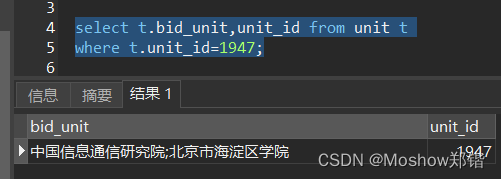列转行
postgresql列转行的思路主要是利用string_to_array进行数组转换,然后用unnest进行行拆分

select t.bid_unit,unit_id from unit t where t.unit_id=1947; result=> 中国信息通信研究院;北京市海淀区学院 -- by zhengkai.blog.csdn.net

select unnest(string_to_array(t.bid_unit,';')),unit_id from unit t where t.unit_id=1947; result=> 中国信息通信研究院 北京市海淀区学院 -- by zhengkai.blog.csdn.net
pgsql官方对functions-array的解释
| Function | Return Type | Description | Example | Result |
|---|---|---|---|---|
| string_to_array(text, text [, text]) | text[] | splits string into array elements using supplied delimiter and optional null string (使用提供的分隔符和可选的空字符串将字符串分割为数组元素) | string_to_array(‘xx^yy^zz’, ‘^’, ‘yy’) | {xx,NULL,zz} |
| unnest(anyarray) | setof anyelement | expand an array to a set of rows(将数组展开到一组行) | unnest(ARRAY[1,2]) | 1 2 (2 rows) |
行转列
用postgresql的crosstab交叉函数
-- by zhengkai.blog.csdn.net create table sales(year int, month int, qty int); insert into sales values(2022, 1, 1000); insert into sales values(2022, 2, 1500); insert into sales values(2022, 7, 500); insert into sales values(2022, 11, 1500); insert into sales values(2022, 12, 2000); insert into sales values(2023, 1, 1200); select * from crosstab( 'select year, month, qty from sales order by 1', 'select m from generate_series(1,12) m' ) as ( year int, "Jan" int, "Feb" int, "Mar" int, "Apr" int, "May" int, "Jun" int, "Jul" int, "Aug" int, "Sep" int, "Oct" int, "Nov" int, "Dec" int ); year | Jan | Feb | Mar | Apr | May | Jun | Jul | Aug | Sep | Oct | Nov | Dec ------+------+------+-----+-----+-----+-----+-----+-----+-----+-----+------+------ 2022 | 1000 | 1500 | | | | | 500 | | | | 1500 | 2000 2023 | 1200 | | | | | | | | | | | (2 rows)
可以参考pgsql官方的tablefunc实用说明
| Function | Returns | Description |
|---|---|---|
| normal_rand(int numvals, float8 mean, float8 stddev) | setof float8 | Produces a set of normally distributed random values(产生一组正态分布的随机值) |
| crosstab(text sql) | setof record | Produces a “pivot table” containing row names plus N value columns, where N is determined by the row type specified in the calling query(生成一个包含行名和N个值列的“数据透视表”,其中N个由调用查询中指定的行类型决定) |
| crosstabN(text sql) | setof table_crosstab_N | Produces a “pivot table” containing row names plus N value columns. crosstab2, crosstab3, and crosstab4 are predefined, but you can create additional crosstabN functions as described below(生成一个包含行名和N个值列的“数据透视表”。交叉表2、交叉表3和交叉表4都是预定义的,但是您可以创建额外的跨表n函数,如下面所述) |
| crosstab(text source_sql, text category_sql) | setof record | Produces a “pivot table” with the value columns specified by a second query(生成具有由第二个查询指定的值列的“数据透视表”) |
| crosstab(text sql, int N) | setof record | Obsolete version of crosstab(text). The parameter N is now ignored, since the number of value columns is always determined by the calling query(过时版本的交叉表(文本)。参数N现在被忽略,因为值列的数量总是由调用查询决定) |
| connectby(text relname, text keyid_fld, text parent_keyid_fld [, text orderby_fld ], text start_with, int max_depth [, text branch_delim ]) | setof record | Produces a representation of a hierarchical tree structure(生成层次树结构的表示) |
总结
版权声明:除特别声明外,本站所有文章皆是本站原创,转载请以超链接形式注明出处!







